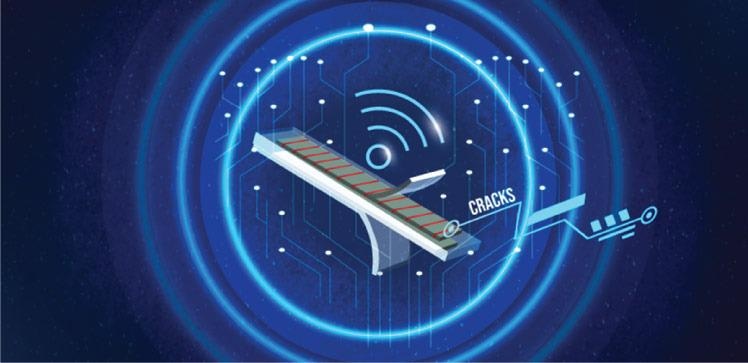The ability to gain control over the structure of fragmented electrodes made of carbon nanotubes could enable enhanced wireless monitoring of the strain on materials in a broad array of applications.
 KAUST scientists develop a sensor that can monitor the strain in materials and wirelessly communicate the signal, which is particularly useful for measuring strain in hard-to-reach places. Image Credit: © 2021 KAUST; Veronica Moraru.
KAUST scientists develop a sensor that can monitor the strain in materials and wirelessly communicate the signal, which is particularly useful for measuring strain in hard-to-reach places. Image Credit: © 2021 KAUST; Veronica Moraru.
This opens endless possibilities for every situation where accurate wireless monitoring of structures is important.
Gilles Lubineau, Professor of Mechanical Engineering, King Abdullah University of Science and Technology
The technology was developed by Lubineau along with postdoc Hussein Nesser, who added, “Our sensor can directly be used to assess, in-situ and with great accuracy, the strain exerted on materials.”
For verifying the safety of everything, from buildings and bridges to ships and aircraft, it is crucial to track the strains imposed on materials. Moreover, strain sensors are essential sub-devices for supervising aspects of robotics, sports performance and health. Natural, manufactured and living structures are all vulnerable to stresses and strains that can compromise their integrity.
A majority of the strain sensors are made of a material that has the ability to convert physical deformation into variations in electrical capacitance or resistance. The consequent electrical signals have conventionally been carried to the detecting devices through wires, but in recent years, wireless technology is delivering the clear advantages of remote sensing.
This seems to be particularly beneficial for detecting the strains on materials in hard-to-reach locations, like inbuilt structures, vehicles or inside the body.
However, the wireless systems that are available at present are beset by issues of low sensitivity. Scientists from KAUST have addressed these problems by initiating a unique pattern of cracks into fragmented electrodes by which the sensitivity of the electrical responses is greatly increased.
Although the researchers were working on such a concept for resistive sensors, this is the first time it has been used for capacitive sensors that are more appropriate for passive wireless applications.
Typically, their sensor is an electrical capacitor with carefully fragmented electrodes composed of carbon nanotube-containing paper. The electrical changes brought about by different levels of strain produce signals that can be wirelessly captured through electromagnetic coupling.
Our innovation brings high gauge factor to the world of wireless strain detection.
Gilles Lubineau, Professor of Mechanical Engineering, King Abdullah University of Science and Technology
The gauge factor represents the ratio of the generated electrical signal to the strain level.
As the researchers demonstrated the concept in principle, they now plan to embed it into readily deployable systems appropriate for commercialization. Furthermore, they will examine its use to detect other physical properties of materials besides strain.
Our ultimate objective is to make a new generation of wire-free, battery-free and ultralow-cost sensors.
Hussein Nesser, Postdoc, King Abdullah University of Science and Technology
Journal Reference:
Nesser, H & Lubineau, G (2021) Achieving Super Sensitivity in Capacitive Strain Sensing by Electrode Fragmentation. ACS Applied Materials & Interfaces. doi.org/10.1021/acsami.1c07704.
Source: https://www.kaust.edu.sa/en